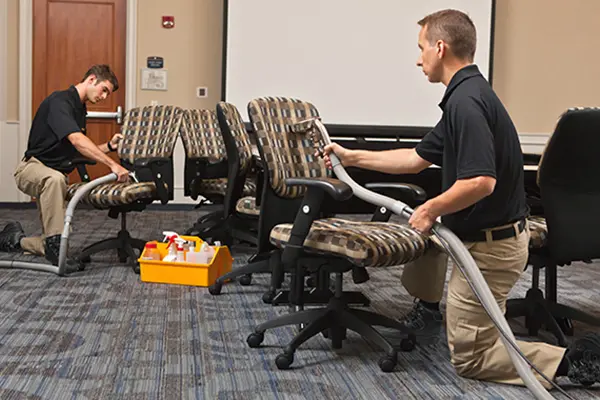Maintaining clean and well-kept furniture in commercial environments is essential for both visual appeal and hygiene. Whether it’s in an office, a hotel, a healthcare facility, or a retail store, furniture plays a role in shaping the experience of clients, customers, and employees. However, many businesses unintentionally make mistakes when it comes to their commercial furniture cleaning routines. These missteps can reduce the lifespan of furniture, lead to unnecessary expenses, or even create health and safety concerns.
In this guide, we’ll explore the most common mistakes companies make with commercial furniture cleaning and how to avoid them for a more effective and efficient maintenance plan.
1. Using the Wrong Cleaning Products
One of the most frequent mistakes in commercial furniture cleaning is using generic or household cleaning products on specialized materials. Office furniture often includes fabrics, leathers, or synthetic materials that require specific care. For instance, using harsh chemicals on leather can cause it to crack or fade, while over-wetting upholstered items can lead to mold or mildew growth.
Solution: Always read the manufacturer’s guidelines before cleaning any furniture piece. Use industry-approved commercial furniture cleaning solutions suited to the material at hand. If in doubt, consult a professional cleaning service.
2. Overlooking Manufacturer Instructions
Every type of furniture, from chairs to sectional sofas and cubicle panels, comes with manufacturer-recommended maintenance instructions. Ignoring these instructions can void warranties and result in damage to the furniture.
Solution: Store and refer to product manuals or manufacturer websites for cleaning guidelines. These instructions often provide recommendations on cleaning frequency and approved cleaning agents for each material.
3. Infrequent Cleaning Schedules
Another widespread mistake is cleaning commercial furniture only when it appears dirty. Dust, allergens, and bacteria build up over time, even if they are not immediately visible. This not only affects air quality but can also lead to wear and tear.
Solution: Establish a regular commercial furniture cleaning schedule based on usage and foot traffic. High-traffic areas may require weekly or biweekly cleaning, while lower-use zones might need only monthly maintenance. Consistent cleaning helps extend the life of your furniture and keeps your business environment hygienic.
4. Neglecting High-Contact Areas
In environments like lobbies, meeting rooms, or waiting areas, armrests, headrests, and seating surfaces accumulate the most grime and bacteria due to frequent use. Yet these areas are often ignored during routine cleanings.
Solution: Focus attention on high-touch points during cleaning procedures. A targeted approach ensures that these zones remain sanitary and presentable, reducing the spread of germs and enhancing client impressions.
5. DIY Cleaning Without Training
While in-house janitorial staff might handle basic tasks, deep commercial furniture cleaning requires specific knowledge and equipment. DIY cleaning without the proper training can damage fabrics, lead to discoloration, or result in incomplete stain removal.
Solution: Hire professional cleaning technicians trained in commercial furniture cleaning. Certified professionals use the right tools and techniques, ensuring the job is done correctly and efficiently.
6. Ignoring Green Cleaning Options
In today’s environmentally conscious business environment, using harmful chemicals not only raises concerns about health and safety but can also harm your brand’s reputation. Many businesses overlook eco-friendly solutions in their cleaning routines.
Solution: Opt for commercial furniture cleaning services that offer green, non-toxic, and biodegradable cleaning agents. Not only are these safer for the environment, but they also contribute to better indoor air quality for staff and customers.
7. Delaying Stain Treatment
Spills and stains are inevitable in any workplace. However, delaying treatment can allow the stain to set, making it harder to remove and possibly leading to permanent damage.
Solution: Train staff to report or address spills immediately. Keep a quick-response cleaning kit on hand and contact your professional cleaning provider for prompt assistance when needed.
8. Using Excess Water or Steam
While water and steam are commonly used in cleaning processes, overuse can lead to problems such as warping, mold growth, or deterioration of padding and upholstery glue.
Solution: Use water and steam sparingly, and always test on a small area before full application. Ensure that any moisture applied is quickly and completely extracted using commercial-grade equipment.
9. Ignoring Office Chairs and Cubicle Panels
Office chairs and cubicle walls are often neglected during commercial furniture cleaning routines. Yet, they harbor dust, allergens, and odors that can affect indoor air quality and employee comfort.
Solution: Include all fabric and upholstered items in your cleaning plan. Schedule periodic deep cleaning of chairs, dividers, and other frequently used soft furnishings.
10. Choosing Price Over Quality
While budget considerations are important, selecting the lowest-cost provider without assessing their qualifications can lead to subpar results. Poor cleaning can damage expensive furniture and result in more costs down the road.
Solution: Evaluate commercial furniture cleaning providers based on experience, client testimonials, certifications, and eco-friendly practices. Paying a bit more for quality service often results in long-term savings.
Final Thoughts
Avoiding common mistakes in commercial furniture cleaning can help you extend the lifespan of your furniture, maintain a professional appearance, and provide a healthier environment for everyone who enters your space. By understanding the unique requirements of each material, sticking to a consistent schedule, and partnering with knowledgeable professionals, your business can achieve optimal results.
 WhatsApp Us Now
WhatsApp Us Now









